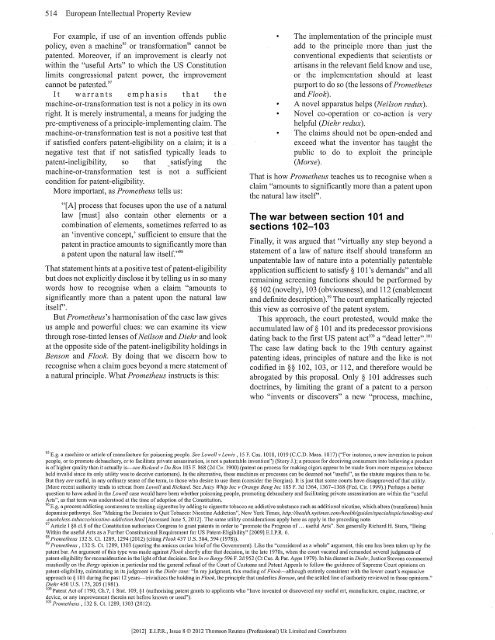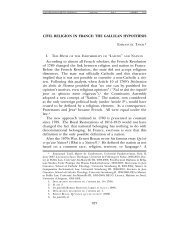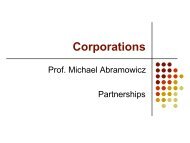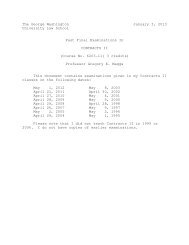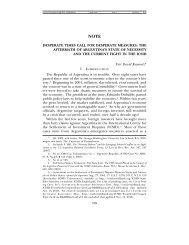Mayo v Prometheus - Gwu - George Washington University
Mayo v Prometheus - Gwu - George Washington University
Mayo v Prometheus - Gwu - George Washington University
Create successful ePaper yourself
Turn your PDF publications into a flip-book with our unique Google optimized e-Paper software.
514 European Intellectual Property Review<br />
For example, if use of an invention offends public<br />
policy, even a machine 95 or transformation 96 cannot be<br />
patented. Moreover, if an improvement is clearly not<br />
within the "useful Arts" to which the US Constitution<br />
limits congressional patent power, the improvement<br />
cannot be patented. 97<br />
It warrants emphasis that the<br />
machine-or-transformation test is not a policy in its own<br />
right. It is merely instrumental, a means for judging the<br />
pre-emptiveness of a principle-implementing claim. The<br />
machine-or-transformation test is not a positive test that<br />
if satisfied confers patent-eligibility on a claim; it is a<br />
negative test that if not satisfied typically leads to<br />
patent-ineligibility, so that ,satisfying the<br />
machine-or-transformation test is not a sufficient<br />
condition for patent-eligibility.<br />
More impmtant, as <strong>Prometheus</strong> tells us:<br />
"[A] process that focuses upon the use of a natural<br />
law [must] also contain other elements or a<br />
combination of elements, sometimes referred to as<br />
an 'inventive concept,' sufficient to ensure that the<br />
patent in practice amounts to significantly more than<br />
a patent upon the natural law itself." 98<br />
That statement hints at a positive test of patent-eligibility<br />
but does not explicitly disclose it by telling us in so many<br />
words how to recognise when a claim "amounts to<br />
significantly more than a patent upon the natural law<br />
itself''.<br />
But <strong>Prometheus</strong>'s harmonisation ofthe case law gives<br />
us ample and powerful clues: we can examine its view<br />
through rose-tinted lenses of Neilson and Diehr and look<br />
at the opposite side of the patent-ineligibility holdings in<br />
Benson and Flook. By doing that we discern how to<br />
recognise when a claim goes beyond a mere statement of<br />
a natural principle. What <strong>Prometheus</strong> instructs is this:<br />
The implementation of the principle must<br />
add to the principle more than just the<br />
conventional expedients that scientists or<br />
mtisans in the relevant field know and use,<br />
or the implementation should at least<br />
purport to do so (the lessons of <strong>Prometheus</strong><br />
and Flook).<br />
A novel apparatus helps (Neilson redux).<br />
Novel co-operation or co-action is very<br />
helpful (Diehr redux).<br />
The claims should not be open-ended and<br />
exceed what the inventor has taught the<br />
public to do to exploit the principle<br />
(Morse).<br />
That is how <strong>Prometheus</strong> teaches us to recognise when a<br />
claim "amounts to significantly more than a patent upon<br />
the natural law itself''.<br />
The war between section 101 and<br />
sections 102-1 03<br />
Finally, it was argued that "virtually any step beyond a<br />
statement of a law of nature itself should transform an<br />
unpatentable law of nature into a potentially patentable<br />
application sufficient to satisfy§ 101 's demands" and all<br />
remaining screening functions should be performed by<br />
§§ 102 (novelty), 103 (obviousness), and 112 (enablement<br />
and definite description). 99 The comt emphatically rejected<br />
this view as conosive of the patent system.<br />
This approach, the court protested, would make the<br />
accumulated law of§ 101 and its predecessor provisions<br />
dating back tO the firSt US patent ad 00 a "dead letter". 101<br />
The case law dating back to the 19th century against<br />
patenting ideas, principles of nature and the like is not<br />
codified in§§ 102, 103, or 112, and therefore would be<br />
abrogated by this proposal. Only § 101 addresses such<br />
doctrines, by limiting the grant of a patent to a person<br />
who "invents or discovers" a new "process, machine,<br />
95 E.g. a machine or article of manufacture for poisoning people. See Lowell v Lewis , 15 F. Cas. 1018, I 019 (C.C.D. Mass. 1817) ("For instance, a new invention to poison<br />
people, or to promote debauchety, or to facilitate private assassination, is not a patentable invention") (Story J.); a process for deceiving consumers into believing a product<br />
is of higher quality than it actually is-see Rickard v Du Bon 103 F. 868 (2d Cir. 1900) (patent on process for making cigars appear to be made from more expensive tobacco<br />
held invalid since its only utility was to deceive customers). In the altemative, these machines or processes can be deemed not "useful", as the statute requires them to be.<br />
But they are useful, in any ordinary sense of the term, to those who desire to use them (consider the B01·gias ). It is just that some courts have disapproved of that utility.<br />
(More recent authority tends to retreat from Lowell and Rickard. See Juicy Whip Inc v Orange Bang Inc 185 F. 3d 1364, 1367-1368 (Fed. Cir. 1999).) Perhaps a better<br />
question to have asked in the Lowell case would have been whether poisoning people, promoting debauchery and facilitating private assassination are within the "useful<br />
At1s", as that term was understood at the time of adoption of the Constitution.<br />
96 E.g. a process addicting consumers to smoking cigarettes by adding to cigarette tobacco an addictive substance such as additional nicotine, which alters (transfonns) brain<br />
dopamin:e pathways. See "Making the Decision to Quit Tobacco: Nicotine Addiction", New York Times, http:/lhealth.nytimes.com!health/guides/specialtopic/smoking-and<br />
-smokeless-tobacco/nicotine-addiction.html [Accessed June 5, 2012]. The same utility considerations apply here as apply in the preceding note.<br />
97 Article I §8 cl.8 of the Constitution authorises Congress to grant patents in order to "promote the Progress of ... useful Arts". See generally Richard H. Stern, "Being<br />
Within the useful Arts as a Fm1her Constitutional Requirement for US Patent-Eligibility" [2009] E. I. P.R. 6.<br />
98 <strong>Prometheus</strong> 132 S. Ct. 1289, 1294 (2012) (citing Flook 437 U.S. 584, 594 (1978)).<br />
99 <strong>Prometheus</strong>, 132 S. Ct. 1289, 1303 (quoting the amicus curiae brief of the Govemment). Like the "considered as a whole" argument, this one has been taken up by the<br />
patent bar. An argument of this type was made against Flook shortly after that decision, in the late 1970s, when the court vacated and remanded several judgments of<br />
patent-eligibility for reconsideration in the light of that decision. See In re Bergy 596 F. 2d 952 (Ct Cus. & Pat. Apps 1979). In his dissent in Diehr, Justice Stevens commented<br />
caustically on the Bergy opinion in particular and the general refusal of the Court of Customs and Patent Appeals to follow the guidance of Supreme Court opinions on<br />
patent-eligibility, culminating in its judgment in the Diehr case: "In my judgment, this reading of F/ook-although entirely consistent with the lower court's expansive<br />
approach to§ 101 during the past 12 years-trivializes the holding in Flook, the principle that underlies Benson, and the settled line of authority reviewed in those opinions."<br />
Diehr 450 U.S. 175, 205 (1981).<br />
100 Patent Act of 1790, Ch. 7, I Stat. I 09, § l (authorising patent grants to applicants who "have invented or discovered any useful art, manufacture, engine, machine, or<br />
device, or any improvement therein not before known or used").<br />
101 <strong>Prometheus</strong>, 132 S. Ct. 1289, 1303 (2012).<br />
[2012] E.I.P.R., Issue 8 © 2012 Thomson Reuters (Professional) Uk Limited and Contributors


